Comprehensive Report: Building Services in Tall Buildings Construction
VerifiedAdded on 2023/06/07
|18
|2904
|391
Report
AI Summary
This report provides a detailed overview of building services in tall buildings. It begins with an introduction to the challenges and considerations in designing and constructing these complex structures, including the importance of adhering to BIM standards. The report then delves into key building services, including mechanical systems (vertical transportation, water and plumbing, and air conditioning), HVAC systems (heating, ventilation, and air conditioning), fire safety, detection, and mitigation systems, and electrical systems. Each section explores the design, implementation, and maintenance of these systems, highlighting advancements in technology and the importance of energy efficiency and safety. The report also emphasizes the role of stakeholders and adherence to building codes and standards. Finally, the report concludes by summarizing the key findings and the importance of integrated design and risk assessment in the construction of tall buildings.
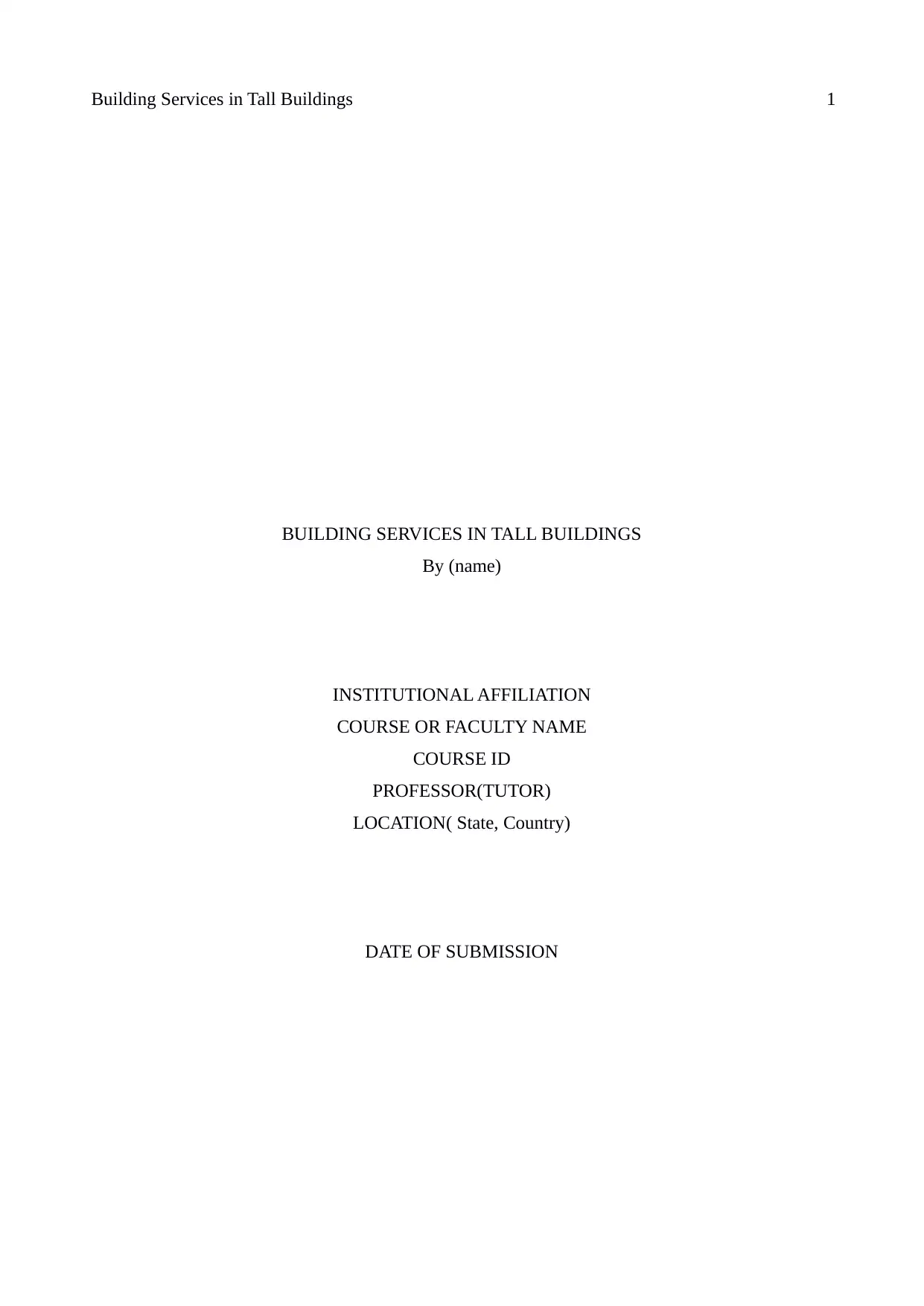
Building Services in Tall Buildings 1
BUILDING SERVICES IN TALL BUILDINGS
By (name)
INSTITUTIONAL AFFILIATION
COURSE OR FACULTY NAME
COURSE ID
PROFESSOR(TUTOR)
LOCATION( State, Country)
DATE OF SUBMISSION
BUILDING SERVICES IN TALL BUILDINGS
By (name)
INSTITUTIONAL AFFILIATION
COURSE OR FACULTY NAME
COURSE ID
PROFESSOR(TUTOR)
LOCATION( State, Country)
DATE OF SUBMISSION
Paraphrase This Document
Need a fresh take? Get an instant paraphrase of this document with our AI Paraphraser
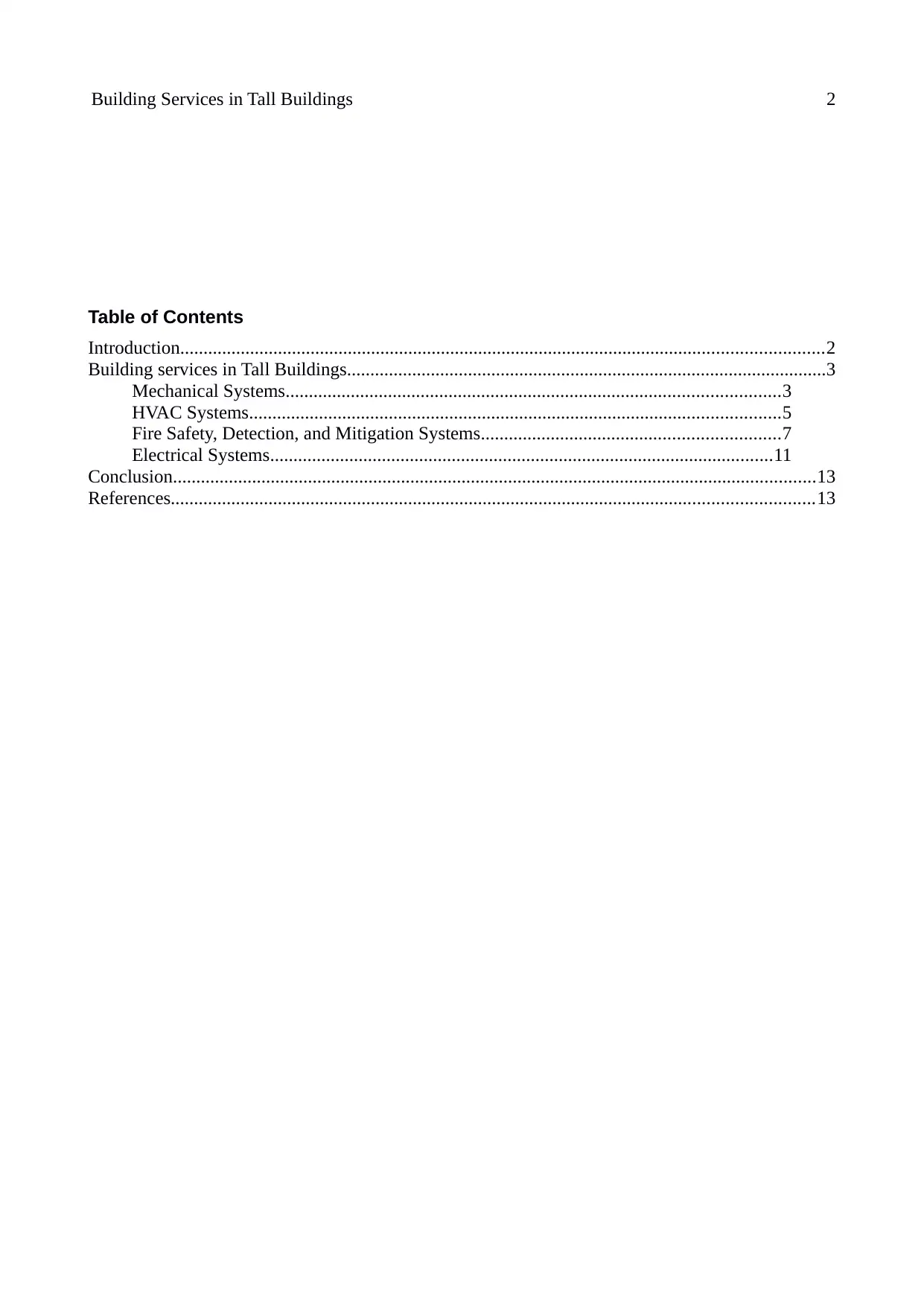
Building Services in Tall Buildings 2
Table of Contents
Introduction..........................................................................................................................................2
Building services in Tall Buildings.......................................................................................................3
Mechanical Systems..........................................................................................................3
HVAC Systems..................................................................................................................5
Fire Safety, Detection, and Mitigation Systems................................................................7
Electrical Systems............................................................................................................11
Conclusion..........................................................................................................................................13
References..........................................................................................................................................13
Table of Contents
Introduction..........................................................................................................................................2
Building services in Tall Buildings.......................................................................................................3
Mechanical Systems..........................................................................................................3
HVAC Systems..................................................................................................................5
Fire Safety, Detection, and Mitigation Systems................................................................7
Electrical Systems............................................................................................................11
Conclusion..........................................................................................................................................13
References..........................................................................................................................................13
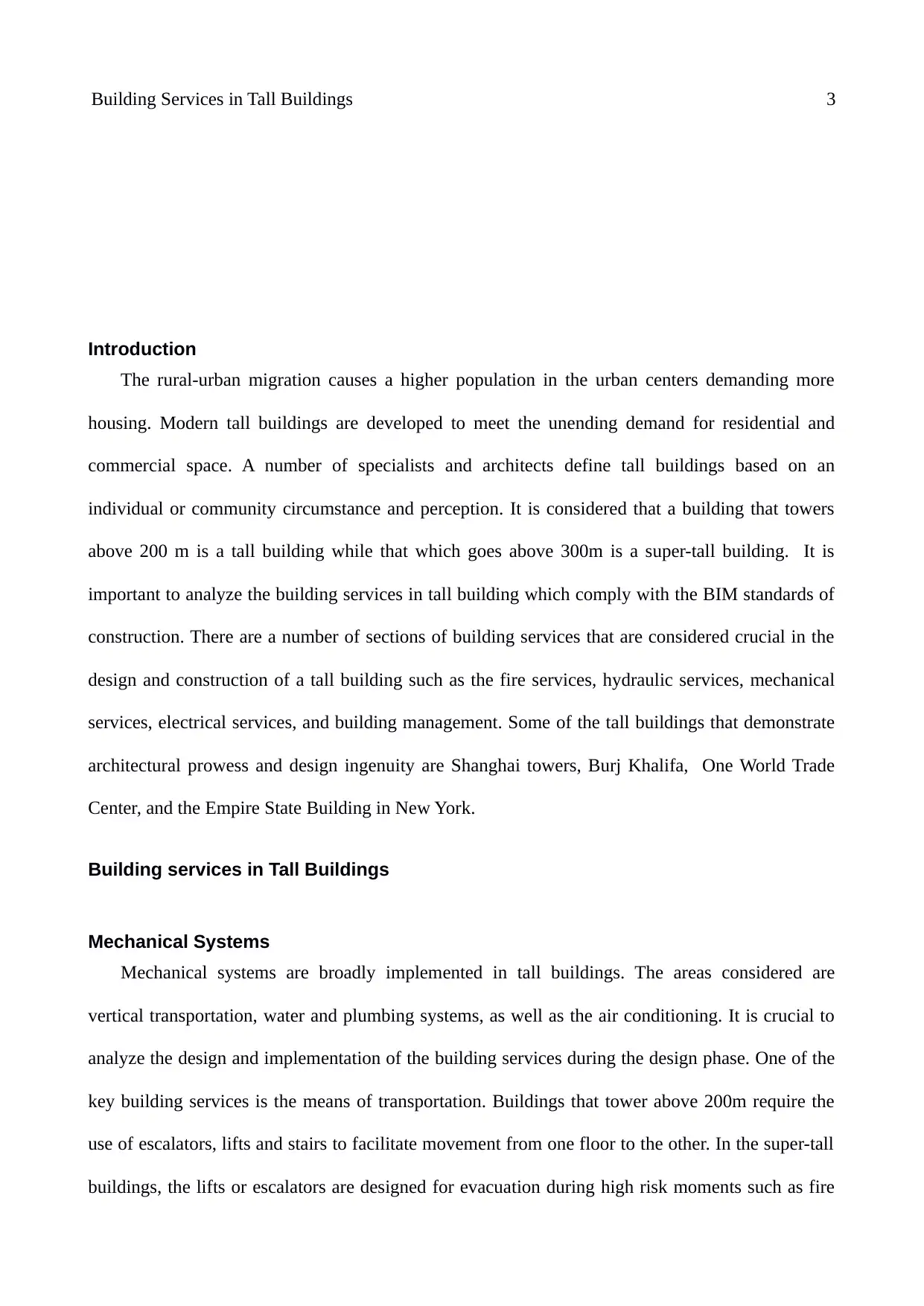
Building Services in Tall Buildings 3
Introduction
The rural-urban migration causes a higher population in the urban centers demanding more
housing. Modern tall buildings are developed to meet the unending demand for residential and
commercial space. A number of specialists and architects define tall buildings based on an
individual or community circumstance and perception. It is considered that a building that towers
above 200 m is a tall building while that which goes above 300m is a super-tall building. It is
important to analyze the building services in tall building which comply with the BIM standards of
construction. There are a number of sections of building services that are considered crucial in the
design and construction of a tall building such as the fire services, hydraulic services, mechanical
services, electrical services, and building management. Some of the tall buildings that demonstrate
architectural prowess and design ingenuity are Shanghai towers, Burj Khalifa, One World Trade
Center, and the Empire State Building in New York.
Building services in Tall Buildings
Mechanical Systems
Mechanical systems are broadly implemented in tall buildings. The areas considered are
vertical transportation, water and plumbing systems, as well as the air conditioning. It is crucial to
analyze the design and implementation of the building services during the design phase. One of the
key building services is the means of transportation. Buildings that tower above 200m require the
use of escalators, lifts and stairs to facilitate movement from one floor to the other. In the super-tall
buildings, the lifts or escalators are designed for evacuation during high risk moments such as fire
Introduction
The rural-urban migration causes a higher population in the urban centers demanding more
housing. Modern tall buildings are developed to meet the unending demand for residential and
commercial space. A number of specialists and architects define tall buildings based on an
individual or community circumstance and perception. It is considered that a building that towers
above 200 m is a tall building while that which goes above 300m is a super-tall building. It is
important to analyze the building services in tall building which comply with the BIM standards of
construction. There are a number of sections of building services that are considered crucial in the
design and construction of a tall building such as the fire services, hydraulic services, mechanical
services, electrical services, and building management. Some of the tall buildings that demonstrate
architectural prowess and design ingenuity are Shanghai towers, Burj Khalifa, One World Trade
Center, and the Empire State Building in New York.
Building services in Tall Buildings
Mechanical Systems
Mechanical systems are broadly implemented in tall buildings. The areas considered are
vertical transportation, water and plumbing systems, as well as the air conditioning. It is crucial to
analyze the design and implementation of the building services during the design phase. One of the
key building services is the means of transportation. Buildings that tower above 200m require the
use of escalators, lifts and stairs to facilitate movement from one floor to the other. In the super-tall
buildings, the lifts or escalators are designed for evacuation during high risk moments such as fire
⊘ This is a preview!⊘
Do you want full access?
Subscribe today to unlock all pages.

Trusted by 1+ million students worldwide
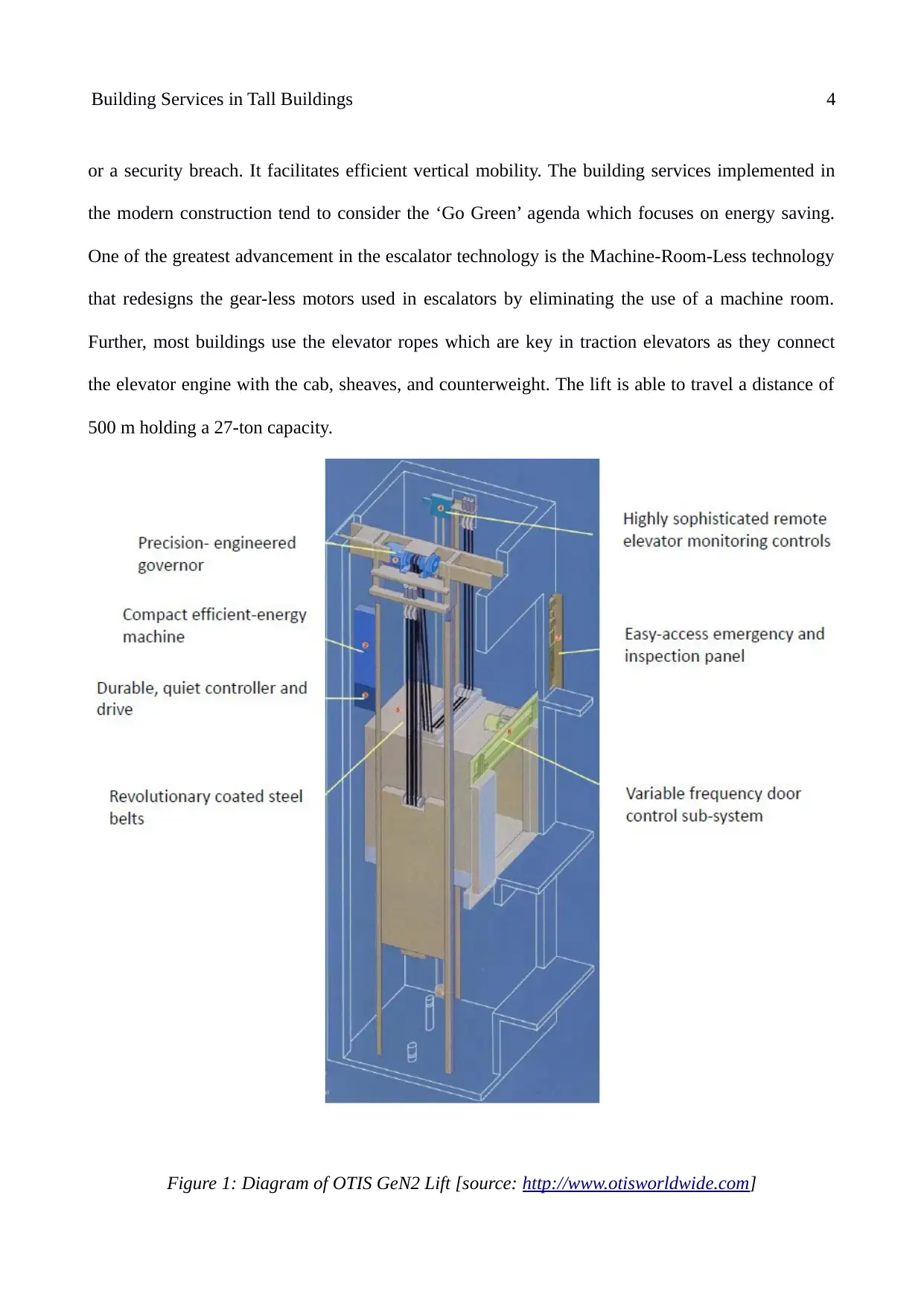
Building Services in Tall Buildings 4
or a security breach. It facilitates efficient vertical mobility. The building services implemented in
the modern construction tend to consider the ‘Go Green’ agenda which focuses on energy saving.
One of the greatest advancement in the escalator technology is the Machine-Room-Less technology
that redesigns the gear-less motors used in escalators by eliminating the use of a machine room.
Further, most buildings use the elevator ropes which are key in traction elevators as they connect
the elevator engine with the cab, sheaves, and counterweight. The lift is able to travel a distance of
500 m holding a 27-ton capacity.
Figure 1: Diagram of OTIS GeN2 Lift [source: http://www.otisworldwide.com]
or a security breach. It facilitates efficient vertical mobility. The building services implemented in
the modern construction tend to consider the ‘Go Green’ agenda which focuses on energy saving.
One of the greatest advancement in the escalator technology is the Machine-Room-Less technology
that redesigns the gear-less motors used in escalators by eliminating the use of a machine room.
Further, most buildings use the elevator ropes which are key in traction elevators as they connect
the elevator engine with the cab, sheaves, and counterweight. The lift is able to travel a distance of
500 m holding a 27-ton capacity.
Figure 1: Diagram of OTIS GeN2 Lift [source: http://www.otisworldwide.com]
Paraphrase This Document
Need a fresh take? Get an instant paraphrase of this document with our AI Paraphraser
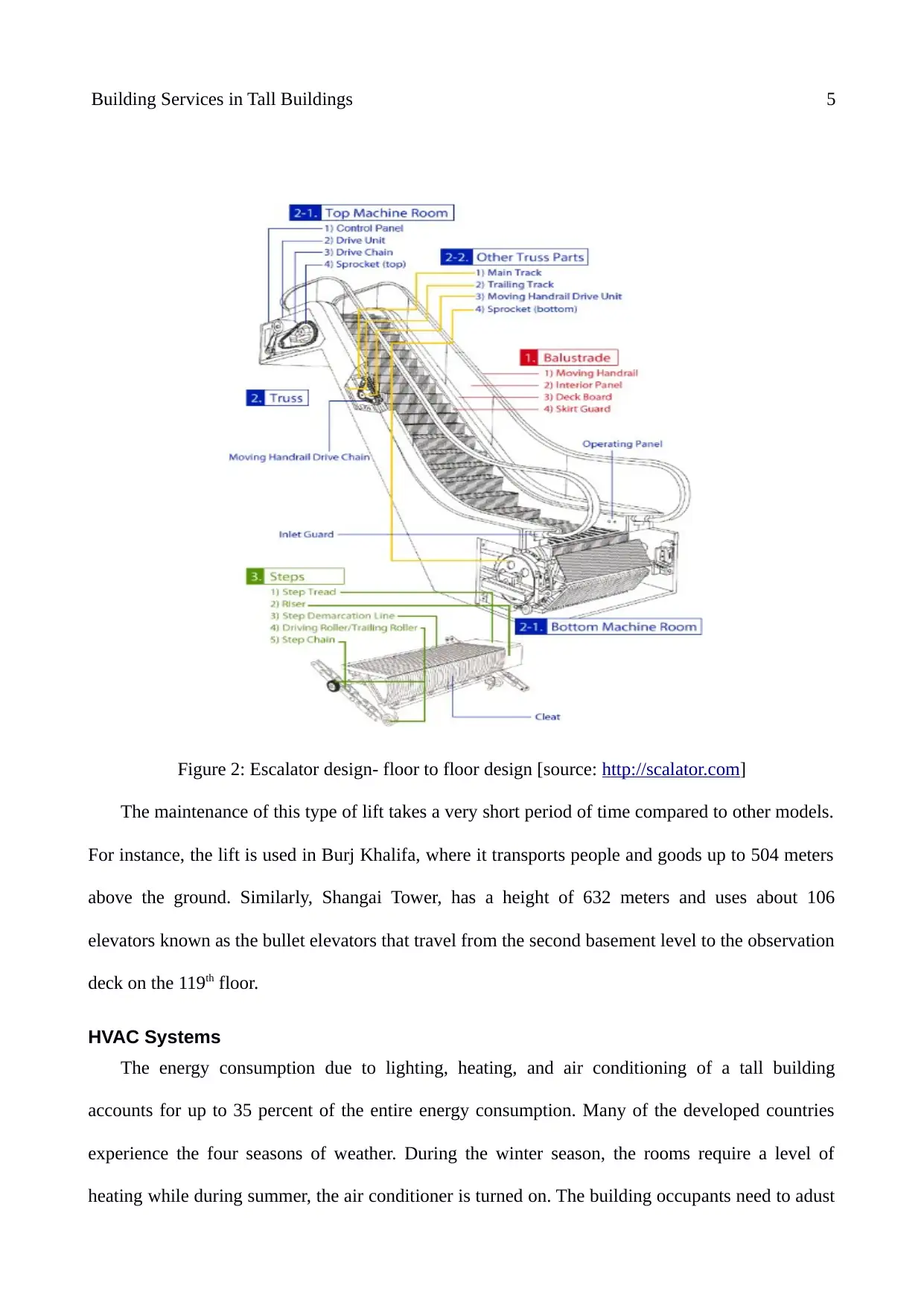
Building Services in Tall Buildings 5
Figure 2: Escalator design- floor to floor design [source: http://scalator.com]
The maintenance of this type of lift takes a very short period of time compared to other models.
For instance, the lift is used in Burj Khalifa, where it transports people and goods up to 504 meters
above the ground. Similarly, Shangai Tower, has a height of 632 meters and uses about 106
elevators known as the bullet elevators that travel from the second basement level to the observation
deck on the 119th floor.
HVAC Systems
The energy consumption due to lighting, heating, and air conditioning of a tall building
accounts for up to 35 percent of the entire energy consumption. Many of the developed countries
experience the four seasons of weather. During the winter season, the rooms require a level of
heating while during summer, the air conditioner is turned on. The building occupants need to adust
Figure 2: Escalator design- floor to floor design [source: http://scalator.com]
The maintenance of this type of lift takes a very short period of time compared to other models.
For instance, the lift is used in Burj Khalifa, where it transports people and goods up to 504 meters
above the ground. Similarly, Shangai Tower, has a height of 632 meters and uses about 106
elevators known as the bullet elevators that travel from the second basement level to the observation
deck on the 119th floor.
HVAC Systems
The energy consumption due to lighting, heating, and air conditioning of a tall building
accounts for up to 35 percent of the entire energy consumption. Many of the developed countries
experience the four seasons of weather. During the winter season, the rooms require a level of
heating while during summer, the air conditioner is turned on. The building occupants need to adust
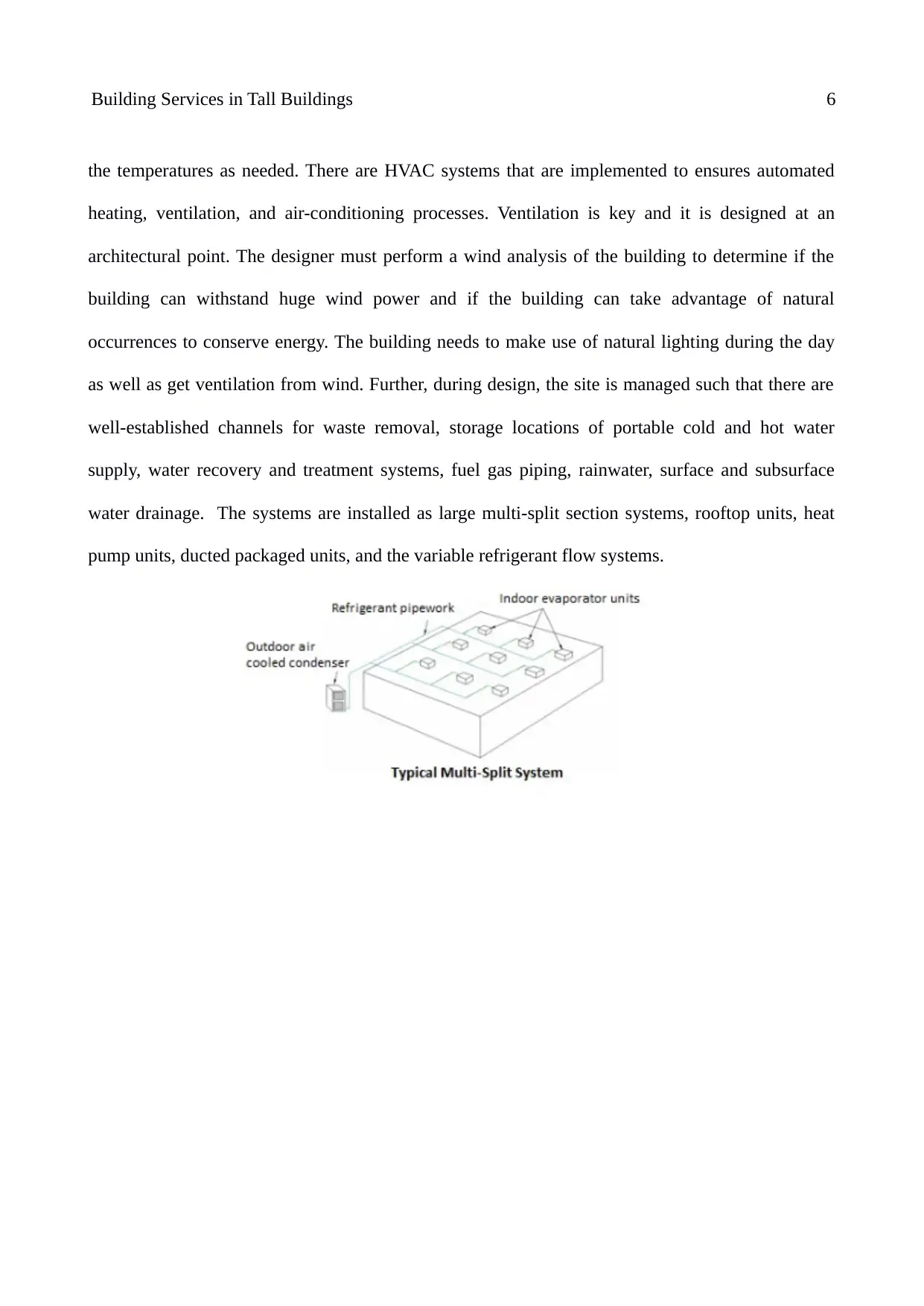
Building Services in Tall Buildings 6
the temperatures as needed. There are HVAC systems that are implemented to ensures automated
heating, ventilation, and air-conditioning processes. Ventilation is key and it is designed at an
architectural point. The designer must perform a wind analysis of the building to determine if the
building can withstand huge wind power and if the building can take advantage of natural
occurrences to conserve energy. The building needs to make use of natural lighting during the day
as well as get ventilation from wind. Further, during design, the site is managed such that there are
well-established channels for waste removal, storage locations of portable cold and hot water
supply, water recovery and treatment systems, fuel gas piping, rainwater, surface and subsurface
water drainage. The systems are installed as large multi-split section systems, rooftop units, heat
pump units, ducted packaged units, and the variable refrigerant flow systems.
the temperatures as needed. There are HVAC systems that are implemented to ensures automated
heating, ventilation, and air-conditioning processes. Ventilation is key and it is designed at an
architectural point. The designer must perform a wind analysis of the building to determine if the
building can withstand huge wind power and if the building can take advantage of natural
occurrences to conserve energy. The building needs to make use of natural lighting during the day
as well as get ventilation from wind. Further, during design, the site is managed such that there are
well-established channels for waste removal, storage locations of portable cold and hot water
supply, water recovery and treatment systems, fuel gas piping, rainwater, surface and subsurface
water drainage. The systems are installed as large multi-split section systems, rooftop units, heat
pump units, ducted packaged units, and the variable refrigerant flow systems.
⊘ This is a preview!⊘
Do you want full access?
Subscribe today to unlock all pages.

Trusted by 1+ million students worldwide
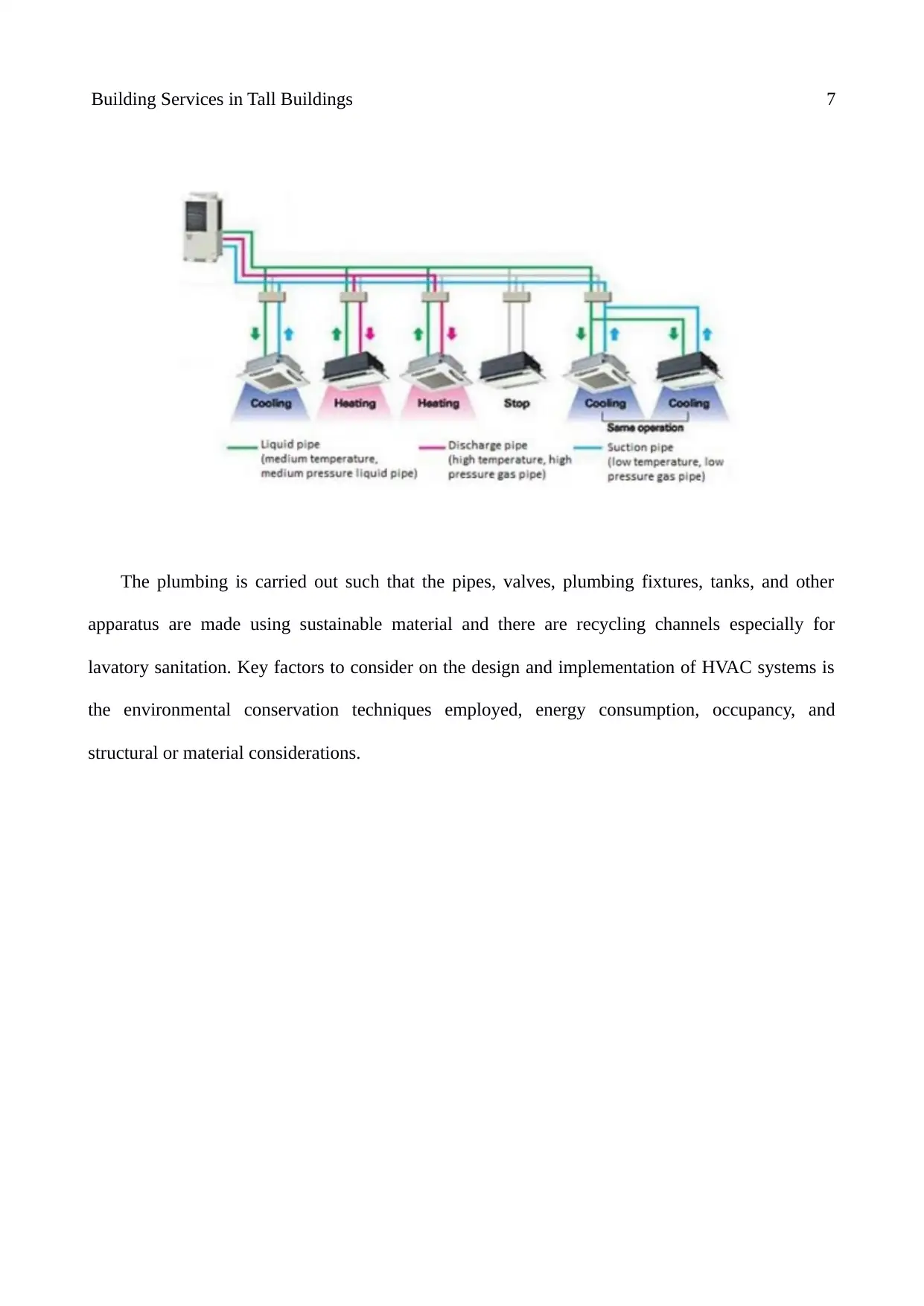
Building Services in Tall Buildings 7
The plumbing is carried out such that the pipes, valves, plumbing fixtures, tanks, and other
apparatus are made using sustainable material and there are recycling channels especially for
lavatory sanitation. Key factors to consider on the design and implementation of HVAC systems is
the environmental conservation techniques employed, energy consumption, occupancy, and
structural or material considerations.
The plumbing is carried out such that the pipes, valves, plumbing fixtures, tanks, and other
apparatus are made using sustainable material and there are recycling channels especially for
lavatory sanitation. Key factors to consider on the design and implementation of HVAC systems is
the environmental conservation techniques employed, energy consumption, occupancy, and
structural or material considerations.
Paraphrase This Document
Need a fresh take? Get an instant paraphrase of this document with our AI Paraphraser
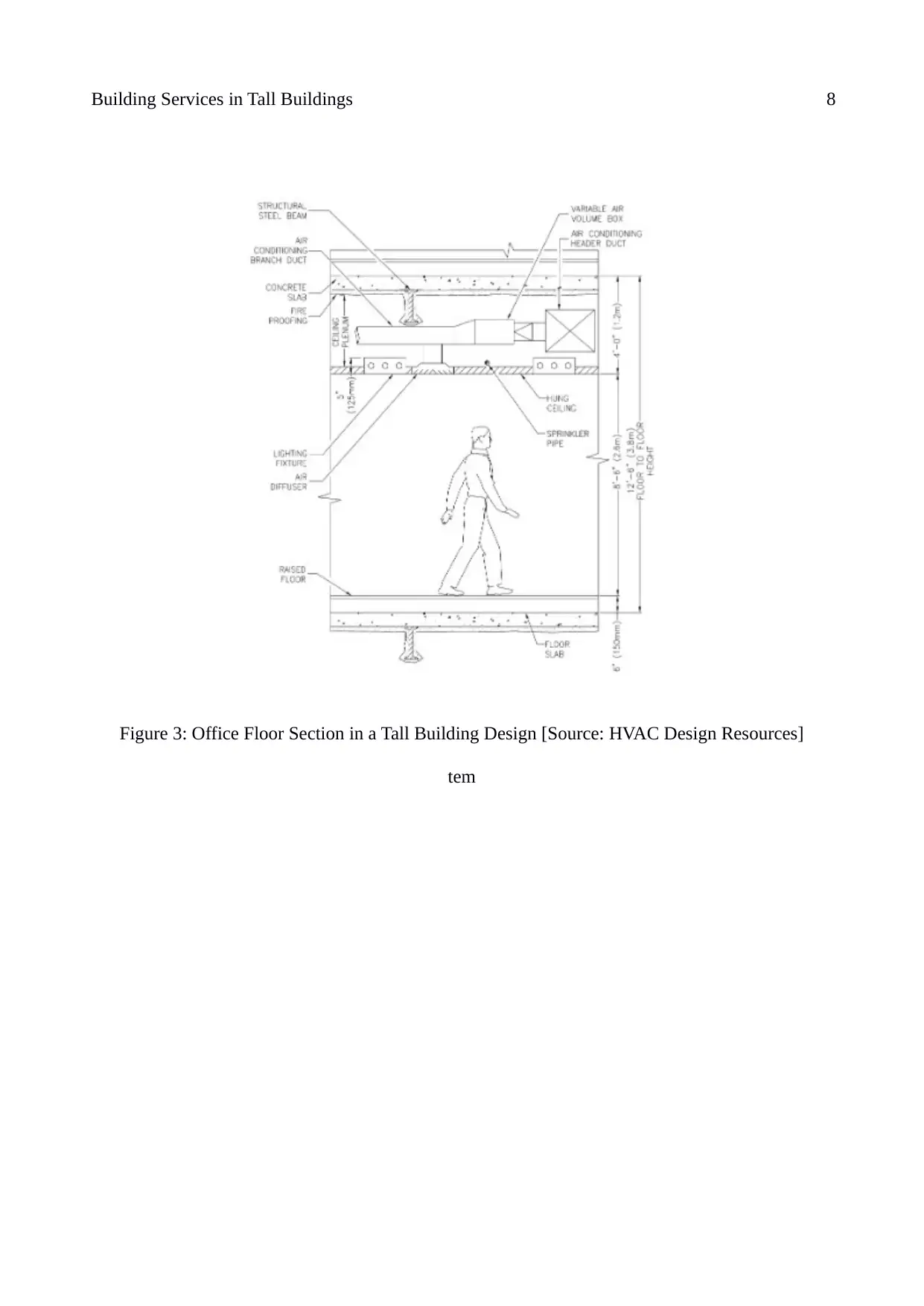
Building Services in Tall Buildings 8
Figure 3: Office Floor Section in a Tall Building Design [Source: HVAC Design Resources]
tem
Figure 3: Office Floor Section in a Tall Building Design [Source: HVAC Design Resources]
tem
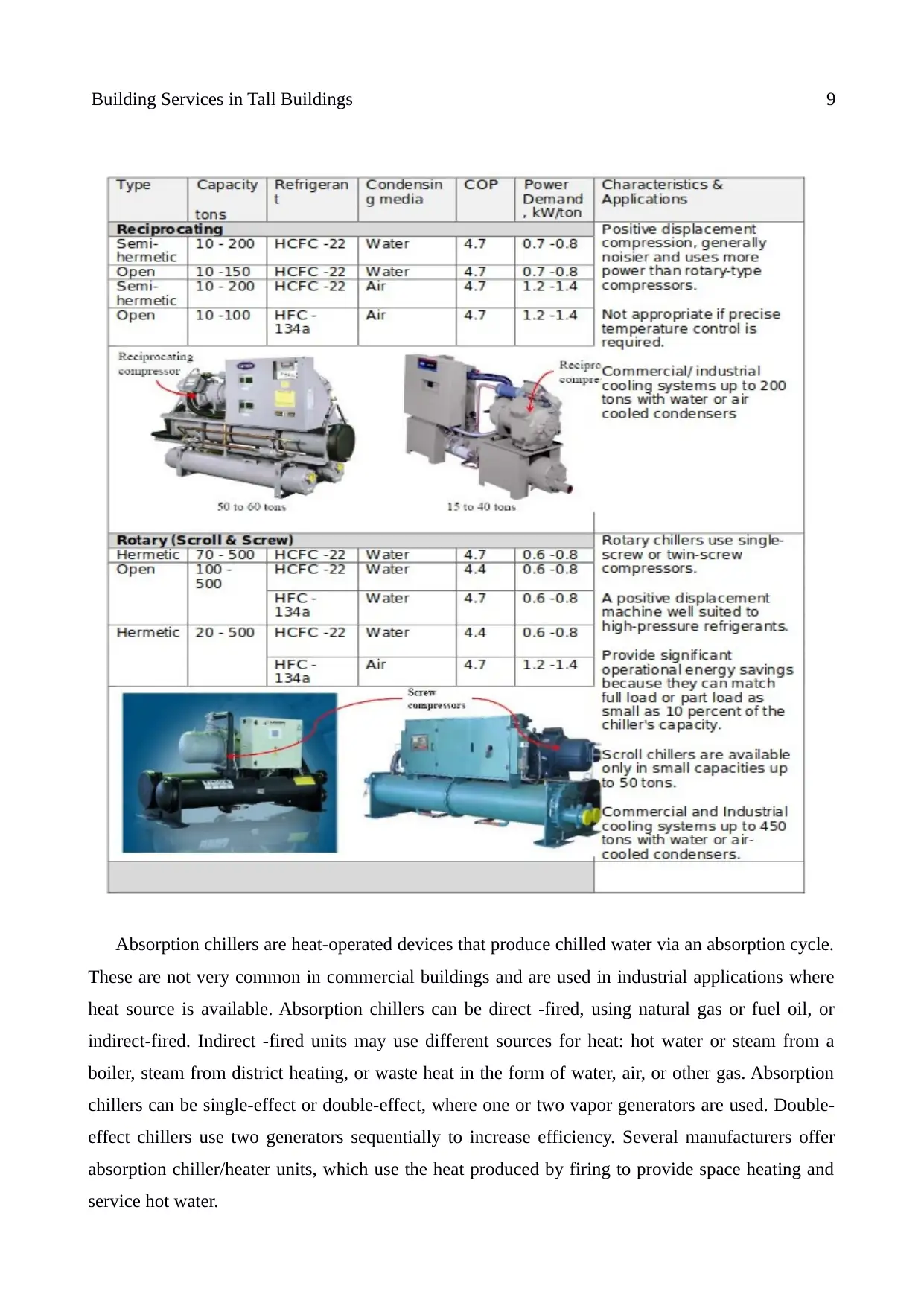
Building Services in Tall Buildings 9
Absorption chillers are heat-operated devices that produce chilled water via an absorption cycle.
These are not very common in commercial buildings and are used in industrial applications where
heat source is available. Absorption chillers can be direct -fired, using natural gas or fuel oil, or
indirect-fired. Indirect -fired units may use different sources for heat: hot water or steam from a
boiler, steam from district heating, or waste heat in the form of water, air, or other gas. Absorption
chillers can be single-effect or double-effect, where one or two vapor generators are used. Double-
effect chillers use two generators sequentially to increase efficiency. Several manufacturers offer
absorption chiller/heater units, which use the heat produced by firing to provide space heating and
service hot water.
Absorption chillers are heat-operated devices that produce chilled water via an absorption cycle.
These are not very common in commercial buildings and are used in industrial applications where
heat source is available. Absorption chillers can be direct -fired, using natural gas or fuel oil, or
indirect-fired. Indirect -fired units may use different sources for heat: hot water or steam from a
boiler, steam from district heating, or waste heat in the form of water, air, or other gas. Absorption
chillers can be single-effect or double-effect, where one or two vapor generators are used. Double-
effect chillers use two generators sequentially to increase efficiency. Several manufacturers offer
absorption chiller/heater units, which use the heat produced by firing to provide space heating and
service hot water.
⊘ This is a preview!⊘
Do you want full access?
Subscribe today to unlock all pages.

Trusted by 1+ million students worldwide
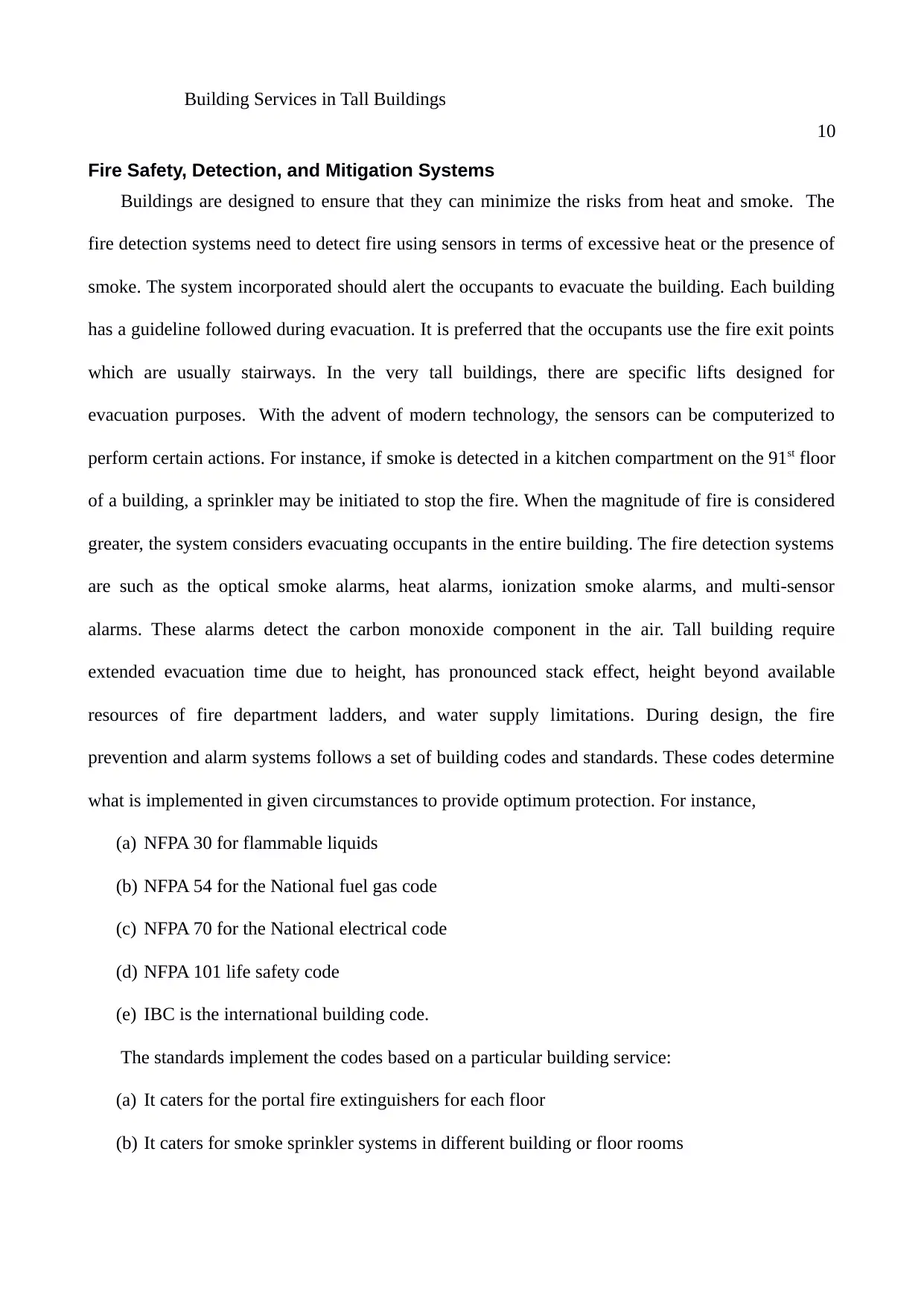
Building Services in Tall Buildings
10
Fire Safety, Detection, and Mitigation Systems
Buildings are designed to ensure that they can minimize the risks from heat and smoke. The
fire detection systems need to detect fire using sensors in terms of excessive heat or the presence of
smoke. The system incorporated should alert the occupants to evacuate the building. Each building
has a guideline followed during evacuation. It is preferred that the occupants use the fire exit points
which are usually stairways. In the very tall buildings, there are specific lifts designed for
evacuation purposes. With the advent of modern technology, the sensors can be computerized to
perform certain actions. For instance, if smoke is detected in a kitchen compartment on the 91st floor
of a building, a sprinkler may be initiated to stop the fire. When the magnitude of fire is considered
greater, the system considers evacuating occupants in the entire building. The fire detection systems
are such as the optical smoke alarms, heat alarms, ionization smoke alarms, and multi-sensor
alarms. These alarms detect the carbon monoxide component in the air. Tall building require
extended evacuation time due to height, has pronounced stack effect, height beyond available
resources of fire department ladders, and water supply limitations. During design, the fire
prevention and alarm systems follows a set of building codes and standards. These codes determine
what is implemented in given circumstances to provide optimum protection. For instance,
(a) NFPA 30 for flammable liquids
(b) NFPA 54 for the National fuel gas code
(c) NFPA 70 for the National electrical code
(d) NFPA 101 life safety code
(e) IBC is the international building code.
The standards implement the codes based on a particular building service:
(a) It caters for the portal fire extinguishers for each floor
(b) It caters for smoke sprinkler systems in different building or floor rooms
10
Fire Safety, Detection, and Mitigation Systems
Buildings are designed to ensure that they can minimize the risks from heat and smoke. The
fire detection systems need to detect fire using sensors in terms of excessive heat or the presence of
smoke. The system incorporated should alert the occupants to evacuate the building. Each building
has a guideline followed during evacuation. It is preferred that the occupants use the fire exit points
which are usually stairways. In the very tall buildings, there are specific lifts designed for
evacuation purposes. With the advent of modern technology, the sensors can be computerized to
perform certain actions. For instance, if smoke is detected in a kitchen compartment on the 91st floor
of a building, a sprinkler may be initiated to stop the fire. When the magnitude of fire is considered
greater, the system considers evacuating occupants in the entire building. The fire detection systems
are such as the optical smoke alarms, heat alarms, ionization smoke alarms, and multi-sensor
alarms. These alarms detect the carbon monoxide component in the air. Tall building require
extended evacuation time due to height, has pronounced stack effect, height beyond available
resources of fire department ladders, and water supply limitations. During design, the fire
prevention and alarm systems follows a set of building codes and standards. These codes determine
what is implemented in given circumstances to provide optimum protection. For instance,
(a) NFPA 30 for flammable liquids
(b) NFPA 54 for the National fuel gas code
(c) NFPA 70 for the National electrical code
(d) NFPA 101 life safety code
(e) IBC is the international building code.
The standards implement the codes based on a particular building service:
(a) It caters for the portal fire extinguishers for each floor
(b) It caters for smoke sprinkler systems in different building or floor rooms
Paraphrase This Document
Need a fresh take? Get an instant paraphrase of this document with our AI Paraphraser
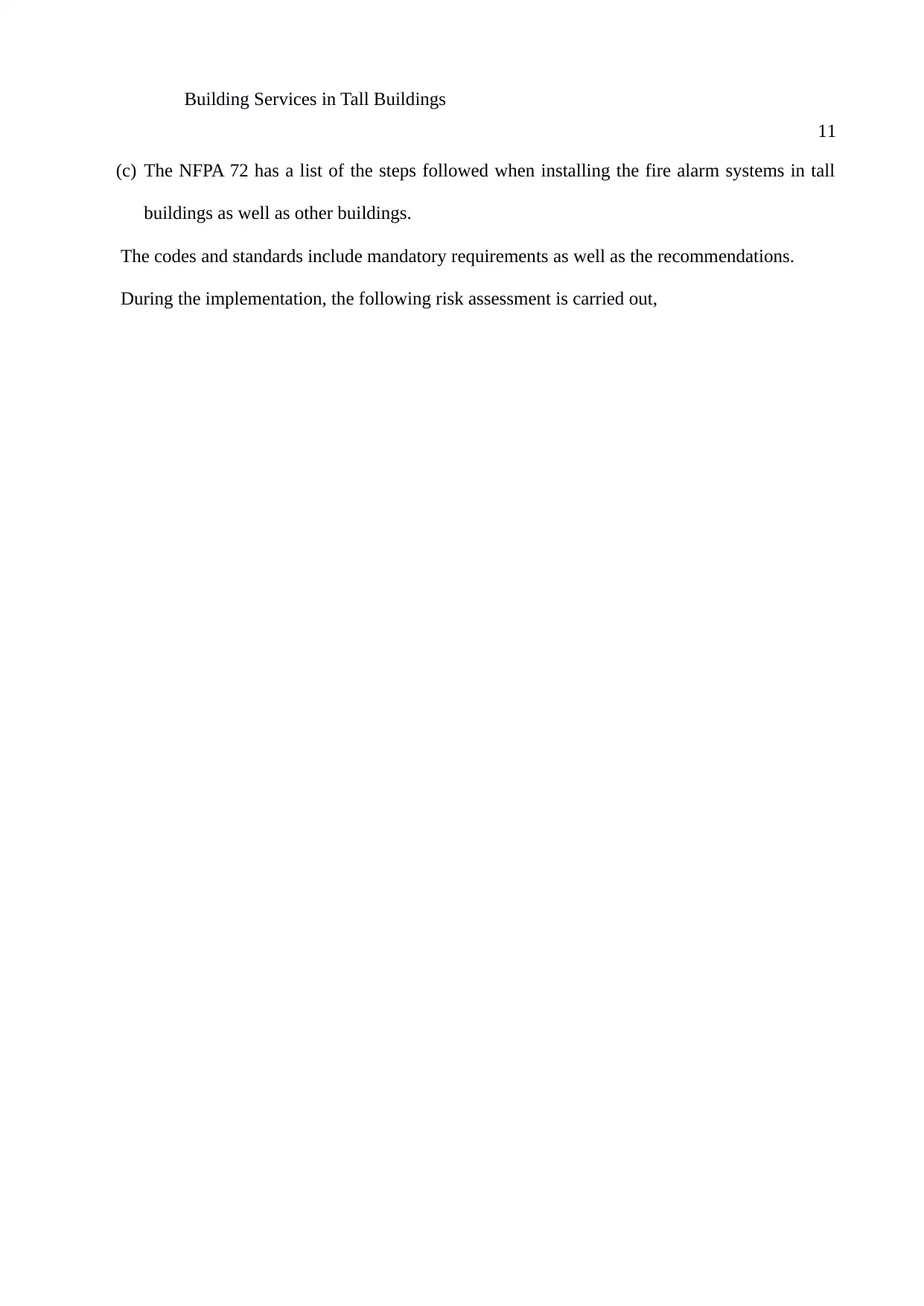
Building Services in Tall Buildings
11
(c) The NFPA 72 has a list of the steps followed when installing the fire alarm systems in tall
buildings as well as other buildings.
The codes and standards include mandatory requirements as well as the recommendations.
During the implementation, the following risk assessment is carried out,
11
(c) The NFPA 72 has a list of the steps followed when installing the fire alarm systems in tall
buildings as well as other buildings.
The codes and standards include mandatory requirements as well as the recommendations.
During the implementation, the following risk assessment is carried out,
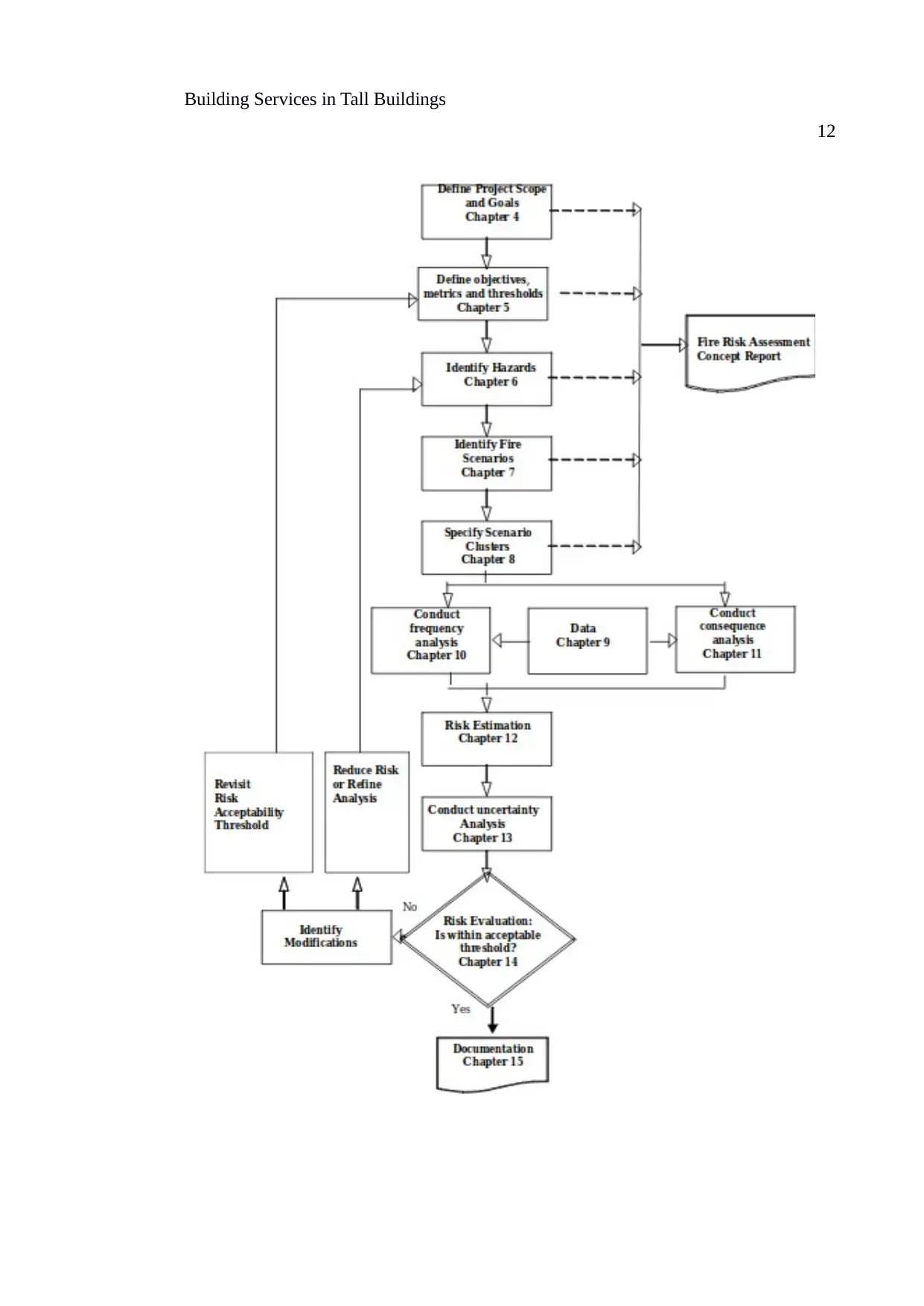
Building Services in Tall Buildings
12
12
⊘ This is a preview!⊘
Do you want full access?
Subscribe today to unlock all pages.

Trusted by 1+ million students worldwide
1 out of 18
Related Documents
Your All-in-One AI-Powered Toolkit for Academic Success.
+13062052269
info@desklib.com
Available 24*7 on WhatsApp / Email
![[object Object]](/_next/static/media/star-bottom.7253800d.svg)
Unlock your academic potential
Copyright © 2020–2025 A2Z Services. All Rights Reserved. Developed and managed by ZUCOL.



